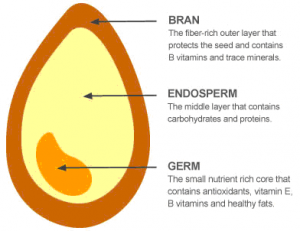Fiber has gotten a lot of attention in the supermarkets over the last 5 to 10 years.
First there were high-fiber breakfast cereals, then there were fiber bars, and now I’ve noticed that there is even fiber being added to sugar packets and yogurt. With all this talk of fiber, a lot of runners I talk to are confused about what fiber is, what fiber does, how much we need, and where to find it naturally.
In this article, I am going to clearly explain what fiber is, how it impacts a runner’s diet, and how it can help you find the perfect snack or meal to eat before running.
What is fiber
Fiber is a component of some carbohydrate-containing foods that cannot be digested or absorbed by our intestinal tracts. In other words, we don’t get energy from fiber. However, even though it doesn’t provide energy, fiber is an important part of the runners diet because it:
- helps keep the intestinal tract healthy and promotes digestion
- helps lower cholesterol (especially “bad” cholesterol)
- promotes regular bowel movements
- slows the digestion of fiber-containing foods which increases satiety and releases glucose into the bloodstream more slowly, which prevents spikes in insulin
To make things even more confusing, there are two types of fiber and some foods can contain both types.
Soluble Fiber
- can dissolve in water and adds thickness (think of the sticky gel that forms when you stir your oatmeal)
- is the type of fiber associated with lowering cholesterol
- helps form firmer stools and leads to slower passing of bowel movements
- too much may result in gas, bloating, and constipation
Insoluble Fiber
- cannot be dissolved in water and thus remains bulky
- helps produce a feeling of fullness (satiety) from a meal
- helps relieve constipation
- too much can lead to diarrhea
Food Sources of Fiber
| Soluble Fiber | Insoluble Fiber |
| Bananas | Wheat bran/cereal/bread |
| Beans | Broccoli |
| Citrus fruits | Cauliflower |
| Berries | Brussels sprouts |
| Oatmeal | Fruits and vegetables with skin |
| Barley | Barley |
| Carrots | Rice (not white rice) |
| Potatoes | Cabbage |
When buying processed foods, it is important to look at the nutrition label to determine if there is fiber in the product, and also if that fiber is naturally occurring.
All fiber is beneficial, but when you eat foods that are made from whole grains, you also get the plethora of vitamins, minerals, and phytochemicals. To help guide you in your selections, here are some terms you should know.
 Whole-grain: This means that the product contains all 3 parts of the whole grain. 1) The bran, which is the outermost layers and the source of most of the grain’s fiber and also some B vitamins. 2) The germ, which is the most nutrient-rich part of the grain. 3) The endosperm, which is the starchy part of the grain which contains carbohydrates and some protein.
Whole-grain: This means that the product contains all 3 parts of the whole grain. 1) The bran, which is the outermost layers and the source of most of the grain’s fiber and also some B vitamins. 2) The germ, which is the most nutrient-rich part of the grain. 3) The endosperm, which is the starchy part of the grain which contains carbohydrates and some protein.
Refined: This means that the bran and the germ layers have been stripped away, leaving just the endosperm. When grains are refined they have lost most of their fiber as well as many vitamins, minerals, and other nutrients.
Enriched: This means that some of the nutrients that were stripped away during processing are added back. The main vitamins and minerals that are added back to grain products are thiamin (B1), riboflavin (B2), niacin (B3), iron, and folic acid. However, enriched foods do not necessarily contain the same level of vitamins and minerals that naturally occurred in the grain.
Fortified: This means that nutrients are added to a food that are not naturally found in the food. An example of this is orange juice fortified with calcium.
In addition to fiber, whole grains offer an array of vitamins and minerals, which is why we place more emphasis on whole grains and try to limit our intake of refined grains.
Fiber and running
A high-fiber diet can affect the digestive system and make training uncomfortable for runners. Common symptoms associated with a high fiber diet include gas and bloating, diarrhea, and feeling uncomfortably full. Furthermore, fiber takes up water and thus can leave you feeling heavy.
As such, when trying to figure out what food is the best for you to eat before a run, it is important to experiment and see how fiber and different types of fiber-containing foods affect you.
The same size snack eaten at a similar time may affect your stomach differently based on how much fiber is contained in each food.
If you find that you are extra sensitive to fiber before and during exercise, then save your whole grains and fiber-containing foods for a time later in the day.
Also be aware that your body may take time to adapt to a high fiber diet, especially if your previous diet was low in fiber. Gas production may be common and is a result of your body’s inability to completely break down all of the sugars in a high-fiber food. The more you get used to eating those types of foods, the more enzymes and good bacteria your body will begin to make and the more you will be able to break down the sugars, resulting is less gas production and a more settled stomach.
It is recommended that adult men consume ~38 grams of fiber each day and that adult women consume ~25 grams of fiber each day. Not enough fiber could lead to constipation while too much fiber could result in diarrhea.
Also, the more fiber you eat the more fluids you should consume to help it pass otherwise you could end up with constipation. A more severe side effect of too much fiber and not enough water could be intestinal blockage where fiber blocks other foods from passing through the intestines.
For these reasons it is important to meet your daily requirements for fiber without overdoing it. As is often the case with nutrition, more of a good thing is not always better.




